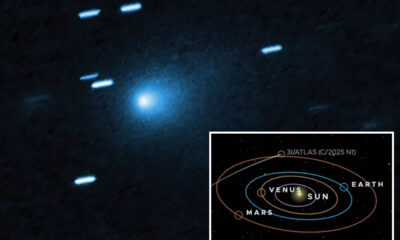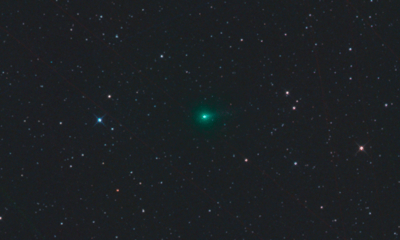Science
New Research Reveals Risks of Interstellar Objects to Earth

Interstellar objects (ISOs) pose a potential impact risk to Earth, according to new research led by Darryl Seligman, an assistant professor at Michigan State University. This study titled “The Distribution of Earth-Impacting Interstellar Objects” investigates how these celestial visitors, including the recently observed 3I/ATLAS, may affect our planet. The findings highlight the need for increased awareness of ISOs and their trajectories as they traverse our solar system.
Three known ISOs have passed through the inner solar system: Oumuamua in 2017, 2I/Borisov in 2019, and currently, the interstellar comet 3I/ATLAS. While it is estimated that numerous ISOs have entered our solar system over its 4.6 billion-year history, the risk of impact remains significant. The research suggests that some of these objects may have contributed to ancient impact craters on Earth, such as the Vredefort impact structure.
The study underscores that the solar system’s environment has calmed over time, with fewer collisions occurring as material coalesced into terrestrial planets. In contrast, the influx of ISOs has not diminished. The research aims to quantify the potential impact risk these objects pose to Earth, even without definitive estimates of their numbers.
The authors utilized simulations to generate a synthetic population of approximately 10 billion ISOs, focusing on those influenced by M-star kinematics, a category encompassing the most common stars in the Milky Way. This approach allowed them to predict that around 10,000 of these objects could pose a risk of impacting Earth.
The simulations revealed that ISOs are more likely to approach Earth from two primary directions: the solar apex and the galactic plane. The solar apex is where the Sun is moving through its neighborhood in the Milky Way, while the galactic plane is the region with the highest stellar density. This increased likelihood is akin to driving a car in the rain, where the vehicle encounters more raindrops as it speeds forward.
Interestingly, while ISOs from these directions tend to have higher velocities, those that could impact Earth often travel more slowly. This phenomenon is attributed to the gravitational influence of the Sun, which can capture lower-eccentricity hyperbolic bodies into Earth-crossing paths.
Seasonality also plays a role in impact risk. The research indicates that ISOs with the highest impact velocities are more likely to arrive during the spring when Earth is moving towards the solar apex. Conversely, winter presents a higher frequency of potential impactors as Earth faces the solar antapex.
Geographical analysis shows that regions near the equator have a greater risk of ISO impacts. Additionally, the northern hemisphere, home to nearly 90% of the global population, faces a slightly elevated risk.
The researchers caution that their findings apply specifically to ISOs ejected from M-dwarf systems and that different kinematic assumptions may alter the results. Nevertheless, they assert that the core insights will likely hold true across various scenarios.
Importantly, the study does not attempt to predict the number of ISOs that could impact Earth, as such estimates remain elusive. The authors explicitly state, “In this paper we intentionally do not make any definitive predictions about the rates of interstellar impactors.”
The implications of this research extend to future observations, particularly with the Vera Rubin Observatory and its upcoming Legacy Survey of Space and Time (LSST). By enhancing our understanding of the expected distribution of ISOs likely to be detected, astronomers will be better equipped to validate or challenge these findings.
As scientists continue to explore the realm of interstellar objects, this study marks a crucial step towards comprehending their origins, trajectories, and potential impacts on Earth. The growing awareness of ISOs underscores the need for vigilance in monitoring these celestial travelers as they journey through our solar system.
-

 Technology4 months ago
Technology4 months agoDiscover the Top 10 Calorie Counting Apps of 2025
-

 Health2 months ago
Health2 months agoBella Hadid Shares Health Update After Treatment for Lyme Disease
-

 Health3 months ago
Health3 months agoErin Bates Shares Recovery Update Following Sepsis Complications
-

 Technology4 weeks ago
Technology4 weeks agoDiscover 2025’s Top GPUs for Exceptional 4K Gaming Performance
-

 Technology2 months ago
Technology2 months agoElectric Moto Influencer Surronster Arrested in Tijuana
-

 Technology4 months ago
Technology4 months agoDiscover How to Reverse Image Search Using ChatGPT Effortlessly
-

 Technology5 months ago
Technology5 months agoMeta Initiates $60B AI Data Center Expansion, Starting in Ohio
-

 Technology4 months ago
Technology4 months agoRecovering a Suspended TikTok Account: A Step-by-Step Guide
-

 Health4 months ago
Health4 months agoTested: Rab Firewall Mountain Jacket Survives Harsh Conditions
-

 Lifestyle4 months ago
Lifestyle4 months agoBelton Family Reunites After Daughter Survives Hill Country Floods
-

 Technology3 months ago
Technology3 months agoUncovering the Top Five Most Challenging Motorcycles to Ride
-

 Technology4 months ago
Technology4 months agoHarmonic Launches AI Chatbot App to Transform Mathematical Reasoning





















